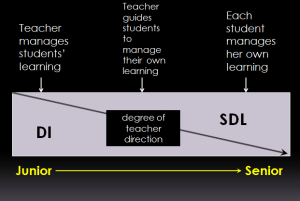“We do not teach a group, but thirty separate people. Because of this, the problem of mixed abilities in the same room seems absolutely natural, and it is the idea of teaching a unitary lesson that seems odd”. (Rinvolucri, 1986)
Rinvolucri’s realization is a common one. In fact, advocates of DI go further, suggesting that it is not just abilities that vary between learners but also degrees of interest and learning styles. All of these variations, it is argued, beg a considered and positive response from the teaching profession. The movement towards catering for all learners also gains support from the fact that in many countries equal access to educational opportunities is enshrined in law.
DI defined
Differentiated instruction is an attempt at a systematic response to learner differences, a framework to help teachers move away from ‘teaching to the middle’. Tailoring lessons for the middle band of students in a class results in some students being over challenged, some under challenged, some unable to gain access to key concepts, and many demotivated. By contrast, with differentiated instruction the aim is to arrange lessons so that all students progress towards desired learning outcomes but reach them in ways that are personally suitable. Lecturers and teachers try to make it possible for all learners to acquire course content, make sense of ideas, and develop learning products that are compatible with their learning profiles.
Historical development of DI
Differentiated instruction is by no means a new phenomenon. Teachers have always practised some degree of differentiation simply by noticing which students require more or less challenge and by asking them different questions. But as a systematic response with a ‘package’ of strategies it is fairly recent. It has been around since the 1980s when it was introduced for the sake of gifted students, and it has received fresh impetus with the move to include students with disabilities into general education classrooms. The cultural make-up of classrooms has also become very diverse with the presence of immigrants and international students. In the United States’ public school system for instance, differentiated instruction has been applied at all levels for students of all abilities. Moreover, it is now an accepted part of pre-service training for teachers in many parts of the world, especially North America, Europe and Australasia.
Supporters of DI
Differentiated instruction has a number of proponents. Key writers on the subject are Susan Winnebrenner (1992, 1996) and Carol Ann Tomlinson (2000). The former writes about particular types of learners, e.g. those with learning difficulties, whereas the latter provides a particularly clear overview. Tomlinson’s book – How to differentiate instruction in mixed-ability classrooms – is available from the ASCD (Association for Supervision and Curriculum Development) in the USA.
Evidence for the value of DI
Tomlinson claims support for her version of differentiated instruction by drawing conclusions from research into teaching and learning:
- Learners must make sense of what teachers seek to impart, and this process is influenced by prior knowledge, interests, beliefs, learning styles, and attitudes about self and the place of learning. (National Research Council, 1990)
- Learning takes place effectively where knowledge is well-organised, students are actively engaged in the learning process, a variety of testing instruments are employed, and students feel secure and have a sense of belonging to their learning environment. (National Research Council, 1990)
- The degree of challenge must be just enough to push learners slightly beyond their independence level. (Vygotsky, 1962)
- Motivation to learn increases when students are interested in what they are trying to learn. (Piaget, 1978)
- People learn in different ways influenced by factors such as brain architecture, culture and gender. (Delpit, 1995; Gardner, 1983; Sternberg, 1985)
The implications, suggests Tomlinson, are that teachers need to provide learning experiences that encourage students to work in their preferred fashion, are motivating, and challenge them appropriately. Additional support for differentiated instruction comes from classroom examples and testimonials from satisfied students and convinced instructors. However, empirical validation of the full model of differentiated instruction is rather lacking. It is an area that warrants future research.
Introducing DI to Schools: A Hong Kong Case Study
I assisted with action research conducted by teaching staff at Hong Kong secondary schools from 2007-1012. The school leaders were intrigued by DI because the approach appeared to be consistent with their institutions’ mission statements such as “[School name] educators should try to handle each one in the way she is made.” Following a series of training workshops to introduce the approach, teachers were given freedom to experiment in their classrooms for one academic year after which principals and vice-principals observed lessons.
The DI strategies that teachers found more immediately useable were as follows: varied questioning, tiered activities, concept-based teaching and minilessons. It was observed that diagnostic pre-assessments were employed insufficiently at first, but when they were introduced, the following strategies became more workable: curriculum compacting and flexible grouping. As peer feedback became common practice in the school, other strategies became practical, namely peer mentoring and jigsaw activities.
Question for teachers
In your experience of using DI, has it really had an impact on learning and grades?
References
Delpit, L. (1995) Other people’s children: Cultural conflict in the classroom. The New Press.
Gardner, H. (1983) Frames of Mind: The theory of multiple intelligences. Basic Books.
National Research Council (1990) How people learn: Brain, mind, experience and school. NationalAcademy Press.
Piaget, J. (1978) Success and understanding. HarvardUniversity Press.
Rinvolucri, M. (1986) Strategies for a mixed ability group. Practical English Teaching, Vol 7/1.
Sternberg, R. (1985) Beyond IQ: A triarchic theory of human intelligence. CambridgeUniversity Press.
Tomlinson, C.A. (2000) How to differentiate instruction in mixed-ability classrooms. ASCD (Association for Supervision and Curriculum Development). LB3061.3 Tom
Vygotsky, L. (1962) Thought and language. MIT Press.
Winnebrenner, S. (1992) Teaching gifted kids in the regular classroom. Free Spirit Publishing.
Winnebrenner, S. (1996) Teaching kids with learning difficulties in the regular classroom. Free Spirit Publishing.

